Understanding the different headers can be daunting if you are new to PC building. A motherboard typically has several headers (connectors) for connecting various devices. One such header type is the USB header. So what are USB Headers?
USB headers are the physical connectors on the motherboard for connecting the extra USB ports on the PC case.
Different types of USB headers are intended for different versions of USB ports on the PC case. So, for instance, a USB 2.0 header is different from a USB 3.0 header.
The following article will discuss USB headers and their different types. First, let us talk about the different USB versions because they are atrociously confusing to the uninitiated.
TABLE OF CONTENTS
Different USB Versions and Their Speed
As you may already know, many different versions of the USB standard exist. But at the same time, know that whoever has been deciding the vocabulary of the other versions (Looking at you -> USB-IF) has wreaked havoc on consumers, particularly with how version 3.0 has been bifurcated.
At the same time, you must understand the different versions as this will give you an insight into not just their speeds but also help you to understand the different types of headers.
There are essentially 8 USB versions/names that you may come across. They are summarized in the table below.
| USB Version | Release Year | Transfer Speed (Gbps) | Interface Options | Remarks | Transfer Mode |
|---|---|---|---|---|---|
| USB 2.0 | 2000 | 0.48 | Type A | – Introduced 0.48 Gbps Speeds | High Speed |
| USB 3.0 | 2008 | 5.0 | Type A | – Introduced 5.0 Gbps speeds | SuperSpeed |
| USB 3.1 Gen 1 | 2013 | 5.0 | Type A Type C | – Same as USB 3.0 | SuperSpeed |
| USB 3.1 Gen 2 | 2013 | 10.0 | Type A Type C | – Introduced 10.0 Gbps speeds | SuperSpeed+ |
| USB 3.2 Gen 1×1 | 2017 | 5.0 | Type A Type C | – Same as USB 3.0 | SuperSpeed |
| USB 3.2 Gen 1×2 | 2017 | 10.0 | Type C | – Dual Channel | SuperSpeed |
| USB 3.2 Gen 2×1 | 2017 | 10.0 | Type A Type C | -Same as USB 3.1 Gen 2 | SuperSpeed+ |
| USB 3.2 Gen 2×2 | 2017 | 20.0 | Type C | – Dual Channel – Introduced 20.0 Gbps speeds | SuperSpeed++ |
You can see how confusing the names of the USBs can be.
Key points to note here are as follows:
- USB 3.0, 3.1 Gen 1, and USB 3.2 Gen 1 are all the SAME, just different names revised over and over with different versions. They all use the specifications called SuperSpeed.
- When we often talk about USB 3.1 speeds, we refer to USB 3.1 Gen 2 speeds (10 Gbps), NOT Gen 1, since USB 3.1 Gen 1 is the same as USB 3.0 (5.0 Gbps).
- USB 3.2 Gen 2 has the exact specifications as the USB 3.1 Gen 2, called SuperSpeed+.
- The only new specification USB 3.2, introduces dual channels usable only over Type C ports. They double the transfer rate of the older specifications. It is thus named USB 3.2 Gen 2×2 (indicating dual channel). This specification is called SuperSpeed++ and can reach 20 Mbps.
- USB 3.2 Gen 1×2 uses the specifications of Gen 3.0 (aka SuperSpeed) and doubles it over two channels (i.e., 5.0 x 2 = 10 Gbps).
- USB 3.2 Gen 2×2 uses the specifications of USB 3.2 Gen 2 (SuperpSpeed+) and doubles it (i.e., 10 x 2 = 20 Gbps), thus conveniently calling itself SuperSpeed++.
If you are confused at first glance, it’s ok. Even the most adept PC builders often do.
The only important USB versions you need to note are the ones where they brought a speed change.
- USB 2.0 = ~0.5 Gbps
- USB 3.0 = 5.0 Gbps (aka USB 3.1 Gen 1, USB 3.2 Gen 2) – SuperSpeed
- USB 3.1 Gen 2 = 10.0 Gbps (aka USB 3.2 Gen 2) – SuperSpeed+
- USB 3.2 Gen 2×2 = 20.0 Gbps – SuperSpeed++
Hopefully, with USB 4.0 around the corner, the naming convention will get a bit simpler.
With that out of the way, let us now look at USB headers.
What are USB Headers?
USB headers are motherboard connectors for connecting the USB ports on the PC Case.
If your PC case has USB ports, it will also come with plugs that need to be connected to the correct headers.
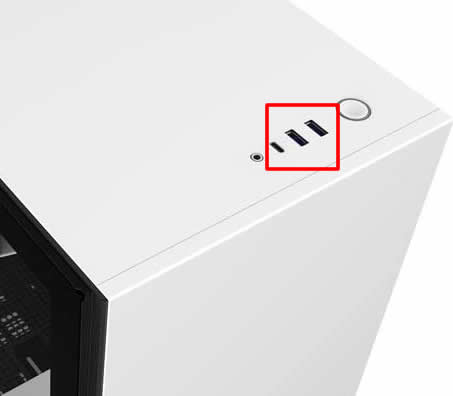
Different USB versions have different USB headers on the motherboard. In other words, a USB 2.0 header differs from a USB 3.0 header.
The following section explains this.
Type of USB Headers
There are essentially four types of USB headers:
- USB 2.0 Header
- USB 3.0 Header
- USB 3.1 Gen 2 Header
- USB 3.2 Gen 2×2 Header
Therefore, depending on what USB ports you have on your PC case, you will connect them to the corresponding header.
So USB 2.0 ports will go into the USB 2.0 header, USB 3.0 ports will go into the USB 3.0 header, and so on.
1. USB 2.0 Header
These are the simplest to follow.
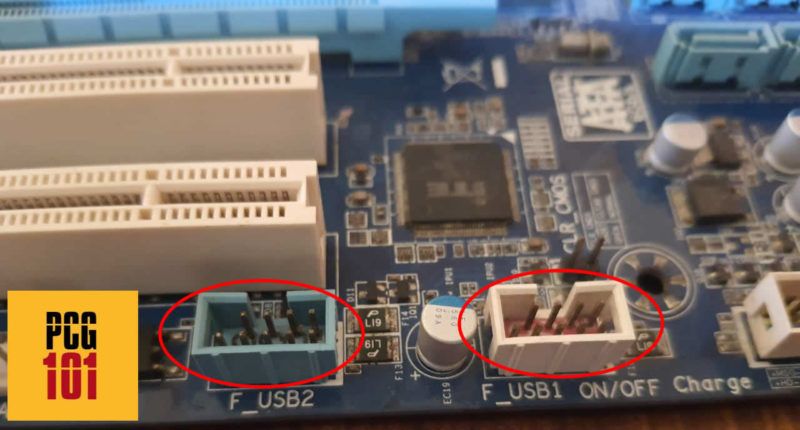
They are small, and their pins are arranged in a 5×2 grid. USB 2.0 headers have 9 pins. The 10th missing pin from the array serves as the key for aligning the plug correctly.
If you have a PC case with USB 2.0 ports, it will be accompanied by this plug:
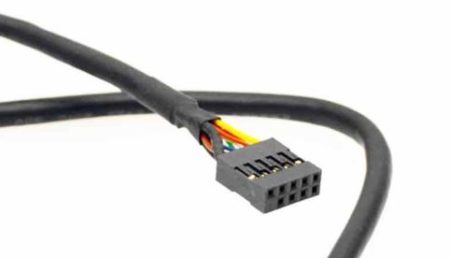
2. USB 3.0 Header – aka USB 3.1 Gen 1, USB 3.2 Gen 1 Header
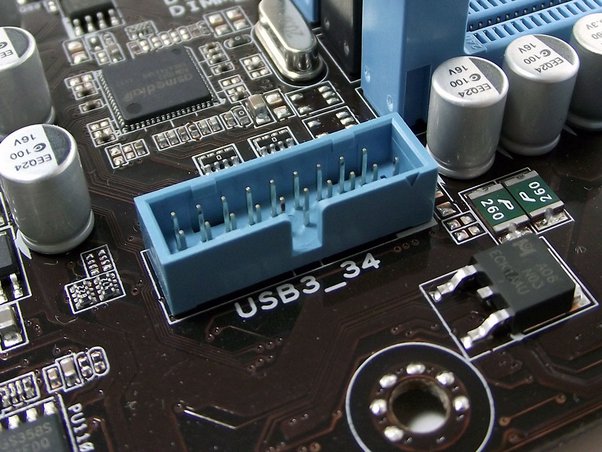
A USB 3.0 header has 19 pins arranged in a 2 x 10 array.
This header has been called by many different names, including
- USB 3.0
- USB 3.1
- USB 3.1 Gen 1
- USB 3.2 Gen 1
The name that you find for this header on a motherboard spec sheet depends upon WHEN the motherboard was manufactured.
The latest motherboards label this header as USB 3.2 Gen 1 header. The older motherboards may have other names.
So basically, as the USB standard changes the terminology, so do the motherboard manufacturers.
But essentially, they are ALL THE SAME.
If you have a PC case with USB 3.0 / 3.1 Gen 1 / 3.2 Gen 2 ports, then it will come with a cable similar to the one shown below:
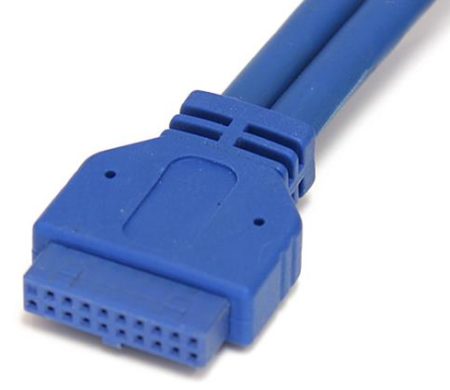
3. USB 3.1 Gen 2 Header – aka USB 3.2 Gen 2 Header
A USB 3.1 Gen 2 header has a unique form factor. It does not have pins sticking out like the rest of the USB headers.
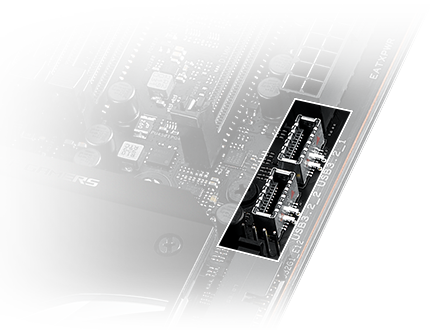
In recent motherboards, this is known as the USB 3.2 Gen 2 header.
If you have a PC case with a relevant port, it will come with the following cable.
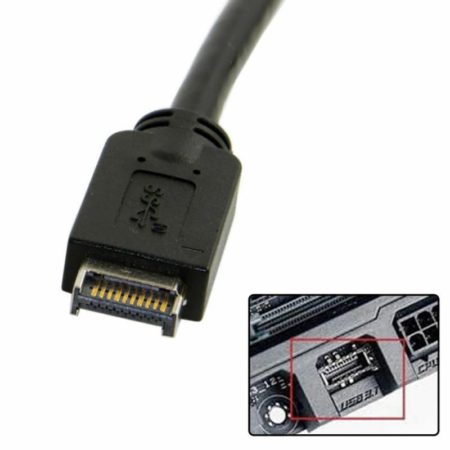
4. USB 3.2 Gen 2×2 Header
These are similar to the USB 3.1 Gen 2 headers above. However, the specifications have dual channels labeled as USB 3.2 Gen 2×2.
These are rare, and only a few top-of-the-line motherboards currently feature this.
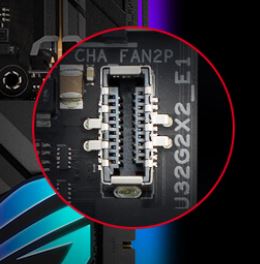
How To Locate USB Headers?
USB headers are often located at the motherboard’s bottom or right edge.
But essentially, there are two ways to find the USB headers precisely.
- Physical Inspection
- Through the Manual
1. Physical Inspection
If you can find your way across the motherboard, USB headers aren’t too difficult to spot.
They are often labeled and may also indicate what version they belong to.
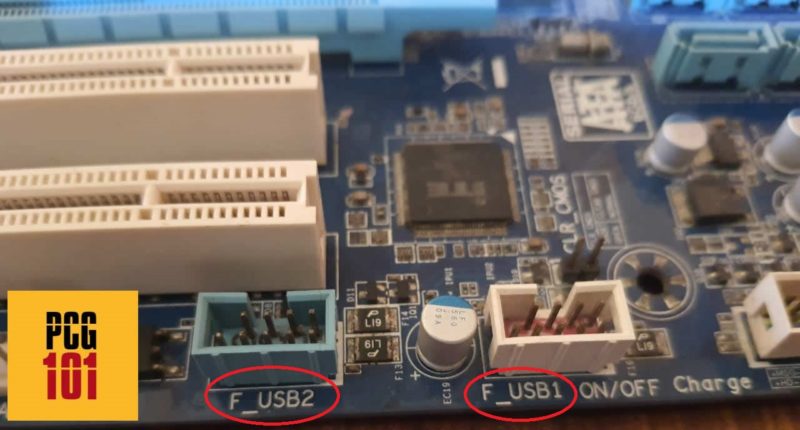
Here you can see that my motherboard has two USB 2.0 headers. They are labeled as F_USB2 and F_USB1. I can tell by the pin count and the header size that it belongs to USB 2.0.
2. Through the Manual
Another easy way to determine where your USB headers are located is to refer to your motherboard’s layout in the manual.
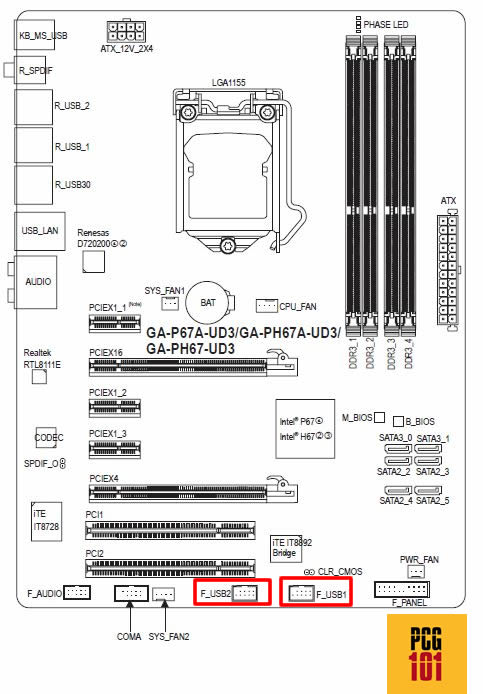
Also Read:
- What are Front Panel Connectors?
- How to Connect Motherboard Internal Speaker?
- What is the difference Between System Fan and a CPU Fan?
Also Read: Why RAM is Called Volatile Memory?
FREQUENTLY ASKED QUESTIONS
1. Can You Use a USB 3.0 Case Port with a 3.2 Motherboard Header?
You can use a USB 3.0 case port if the motherboard header is a 19-pin connector. This is because USB 3.0, USB 3.1 Gen 1, and USB 3.2 Gen 1 ports are identical; they use the same header and connector and have the same transfer speed. If you have a USB 3.1 Gen 12 port, you need to buy an adapter to connect 3.0 case ports.
2. USB Ports on the Back I/O Panel DO NOT Connect to USB Headers
If the USB ports on the back don’t connect to USB headers, it might be because the USB header pins are damaged or even bent.
3. USB Ports on the Case are NOT the Same as USB Expansion Cards
Since a USB expansion card fits into the PCIe slot, it interferes with your PC through the PCIe lanes directly, and does not need to be connected to USB headers.
4. How Many USB Ports a USB Header Can Support?
USB headers can support two USB ports per header, but it depends on the header type.
USB 2.0 Header – Supports 2 USB ports
USB 3.0 Header, now called USB 3.2 Gen 1 Header – Supports 2 USB ports
USB 3.1 Gen 2 Header, now called USB 3.2 Gen 2 Header – supports one port (Usually Type C)
USB 3.2 Gen 2×2 Header – supports one port (Type C only)
5. Is USB 3.2 Gen 2 the Same as Thunderbolt 3?
No, it is not. Thunderbolt 3 ports have different headers and are much faster, at 40GB/s. On the other hand, USB 3.2 is only 10GB/s, and dual channel USB 3.2 Gen 2×2 has a 20GB/s transfer speed. Therefore, Thunderbolt 3.0 is twice as fast as the USB 3.2 Gen 2.


thank you, legit only place I could find a photo of a gen 2 header.
Awesome writeup. Thanks for this. I am building a PC for my music studio and will need to connect over a dozen USB devices. Performance will be critical. This is very helpful.
Will a USB 3.2 Gen 2 Type C cable plug into a USB 3.2 Gen 2×2 Header, and just run a 10Gbps? Or will the cable not fit?
Or will it run at 20 Gbps?
Just above your title “What are USB headers”, you list
1 USB 2.0
2 USB 3.0
3 USB 3.1 Gen 2
4 USB 3.2 Gen 2×2
I belive that you made a mistake on number 2 (both should be Gen 1) – should read:-
2 USB 3.0 = 5.0 Gbps (aka USB 3.1 Gen 1, USB 3.2 Gen 1) – SuperSpeed
I hope this is correct.
Very good descriptions here for those that build their own systems. There is the different hardware configurations. And then the different associated data speed standards. And there is some amount of intermixing of these, which causes all the terminology confusion. Then on top of all that they changed the naming terminology somewhere along the way. To get the full bandwidth, the connecting cables has to be able to take it, irrespective of the connector ends configuration. So the question is about the two MB header connection for the 3.2 2X2 Gen 2, it looks a lot like Gen 1. I am thinking of getting a MB that has one of each of these headers. (10 GB and 20 GB) are they physically interchangeable, or is this yet another hardware cabling set up for the front panel USB-C set-up?
Best Guide I have seen on this. The pictures really help. Thanks much for taking the time to write it.
I am trying to find a USB header to install in the front of a case. The case manufacturers don’t seem to care about keeping up with technology. They still provide type A jacks, when they should be 3.2, 2×2 jacks and thunderbolt jacks. They seem to care more about producing light shows than computers.